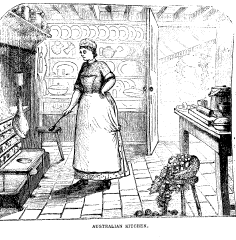
|
Whilst the structure of society has changed, the basic needs of a household are always much the same. As well as recipes, Mrs Beeton's books included detailed information on such things as laying the cloth for breakfast, cleaning patent leather boots and planning family teas so that the mistress of the house might ensure that her servants performed their tasks correctly. The housewife of the 1930's needed the same information so that she could do such things herself. And while today's cookbooks don't give us information on treating cramp in horses, or on the morning duties of the Ladies Maid, the same old valuable hints on choosing fresh fish or removing stains from clothing still appear. Where cookery and health are concerned, things have changed rather more. In every age, the connection between food and health has been acknowledged. But the way that this has been handled in early cookbooks, especially in the advertisements, is often amazing and amusing. Tasty Dishes, in 1883, had no invalid-cookery section but the advertisements strongly recommend a variety of health-aids and cures. Under the heading 'Electricity is Life', a selection of "Medico-Galvanic...bands, belts, batteries, &c.", approved by "Medical Authorities" , are claimed to provide daily increasing numbers of cures for sufferers from conditions such as indigestion, constipation and even epilepsy. Emma Leslie, the "Well known Authoress", wrote a glowing testimonial for another advertiser. She had found the Magnetine Special Power Appliances for Gout, Bronchitis, "And every other form of Nervousness and Rheumatic Affection", so good that she frequently recommended them to friends. The advertisers, themselves, say the the appliances are used by "the Profession" but they neglect to say which profession they mean. Possibly the same profession which regarded Whelpston's Vegetable Purifying Pills as valuable family medicine, and declared Lamplough's Pyretic Saline to be "the true Antidote" superior to imitations put forward by other "unprincipled persons". Mrs Beeton wisely chose not to include advertisements in her books, but she wrote at length and most sensibly on the sick-room, the doctor, contagious diseases, accidents, bandaging, prescriptions and (surprisingly) homoeopathy. Her remedies include poultices and simple lotions, as well as more exotic concoctions such as Poppy Head Fomentation, and drugs like ergot, quinine and the opium derivative, laudanum. She provides a list of common complaints ranging from Acidity and Ague to Piles and Sciatica. And she advocates exercise and cold baths as being "invaluable in promoting and preserving health" but warns against "excessive frequency". By 1915, writers of cookery books appear to have opted for recipes rather than health-care advice. Tried Favourites has a large selection of invalid cookery, and only a few prescriptions and "cures" and hints. But it does have a paragraph on "Rules for a Water Bed" (fill half-full and use warm water) which seems well ahead of its times. The Goulburn Cookery Book is even more forward-looking. Drawing on "convincing" books such as The Science of Eating and The Science of Keeping Young, the author quotes scientists, Danish wartime experiences, and even Moussolini, to advocate a diet of pure water, wholemeal bread, bran, and fresh fruit and vegetables. There is a special, very large selection of health-food recipes for all occasions, and it is prefaced by a lengthy homily on the benefits of healthy food and "good breathing". The only thing we modern housepersons might feel inclined to quibble with is the author's belief that "women...are the Loaf Givers and on them depends the health and well-being of their families". |

